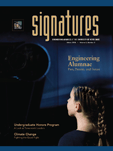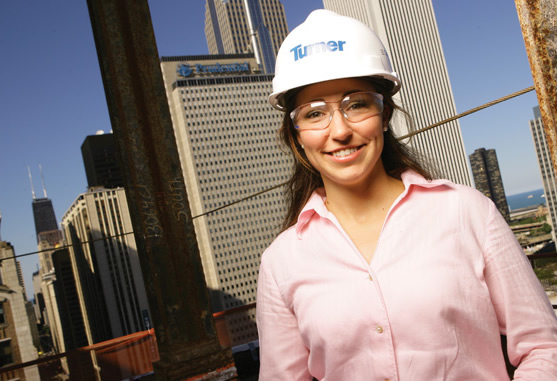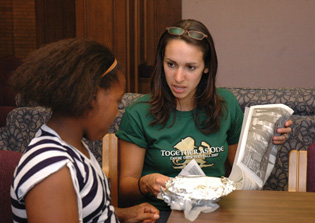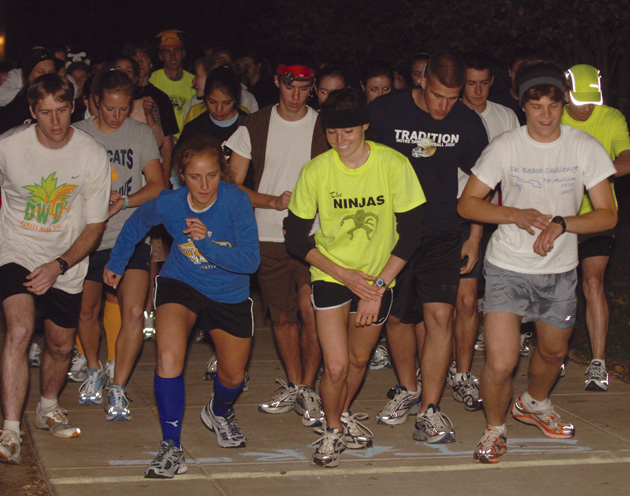
 |
 |
|

Kristin Carey (B.S., CE ’02) was working for Turner Construction Comapny in Chicago when this picture was taken. In addition to working on estimates for the Art Institute of Chicago’s museum wing project, high-rise condominiums, and a local hospital renovation, she served as a field engineer on the Soldier Field renovation. Today, she is a project manager in the Department of Operations for construction and planning at Harvard Business School.
![]()
An all-male school for 130 years, Notre Dame first admitted women in fall 1972. What was it like then, to not only be part of the first class of women at the University, but to also be among the first women engineering students? Was it harder to be a woman in the engineering program? In industry? What is it like today?
Let’s face it, there are still plenty of myths about boys and girls and how they learn, especially regarding math and science. One of the biggest is “Boys are better at math and science than girls are.” Is it true? Is it biological, or do other factors play a role?
Some of the other myths are just as frightening: “Girls don’t like technology,” or “A woman can’t succeed in a male-dominated profession.” Are these myths, or is it really harder, almost impossible, to be a successful woman engineer?
Those are some of the questions we asked Notre Dame engineering alumnae, several of them from the first class of women engineers. Here’s what they had to say about being a woman engineer and about Notre Dame engineering.
WHY DID YOU CHOOSE TO PURSUE ENGINEERING?
At age five, Francesca O’Connor knew she wanted to be an engineer. “My earliest memory of wanting to be an engineer is when the Challenger space shuttle exploded,” she says. “I told my mother if I had worked on the shuttle, the accident never would have happened.” By age seven, she had decided she wanted to be an electrical engineer at Notre Dame. Ten years later, she was a first-year student at the University.
O’Connor (B.S., EE ’02) is currently a systems engineer with Raytheon in San Diego, Calif. She is responsible for naval ship integration on multiple platforms, encompassing a range of systems from architecture to life cycle support.
DO YOU THINK BEING A WOMAN HINDERED ORHELPED YOUR ACCLIMATION TO THE ENGINEERING PROGRAM?
Some of our alumnae felt the college and classes were skewed toward the men. Not Kathleen (Fochler) Piwko (B.S., EE ’90), one of seven women in the electrical engineering class of 1990. “I don’t think that being a woman affected how I acclimated to the engineering program. Every night, my friend, Tina, and I studied at the same table on the second floor of the library. Since we usually had the homework done ahead of time, a lot of guys would come find us if they had questions.”
Piwko does believe, however, that women have a disadvantage in that they don’t generally gravitate toward engineering or technical hobbies. “I remember my brother, who was 12 at the time, understanding how a toaster worked when as a second or third-year engineering student, I had never given it a thought. I think that girls don’t think about life from an ‘engineering’ viewpoint, and if they do, they usually don’t have many girlfriends with whom to share that interest,” she says. A resident of Sparta, N.J., Piwko is a stay-at-home mom. She “retired” as director of the Information Systems Department for Travelers Insurance Company to raise her four children.
As a graduate student in the Department of Chemical and Biomolecular Engineering, Jessica Anderson studied ionic liquids and their potential use in carbon dioxide capture and sequestration. Recently, she acceted a position as visiting assistant professor of chemical engineering at Rose-Hulman Institute of Technology in Terre Haute, Ind., where she is teaching courses on conservation principles, material, and energy balances and also energy and the environment. WHAT IS ONE OF YOUR FAVORITE MEMORIES
ABOUT ENGINEERING AT NOTRE DAME?
Sally (Naxera) Benson (B.S., CE ’76), who now lives in Naperville, Ill., had no trouble coming up with two of her favorite memories. She actually started her college career at Saint Mary’s College in 1972 (math and chemistry), but transferred to Notre Dame in 1974 to pursue a degree in civil engineering. There were fewer than six women enrolled in the college at the time. “I remember the first class I had with the mechanical engineering guys. They knew I was coming to class, so they got there early and filled all the chairs in the room, except one. It was in the front row on the far side of the room,” she says. “There were mumbles, comments, and a few whistles as I sat down. So I politely stood up, turned to the class with my most genuine smile and then said something like ‘Hi, guys. Thanks so much for that warm welcome.’ We were all good friends from then on.”
She also remembered that Professor Jerry J. Marley, now professor emeritus of civil engineering and geological sciences, asked her to start a student group for women engineers. “He told me about an organization called ‘SWE.’ I just wanted to be one of the guys, so I actually argued against bringing a section on campus. I now understand how wrong I was, and what the value of such an organization can be. I’ve even spoken to the Notre Dame section since that time.”WHAT, IF ANYTHING, DO YOU BELIEVE IS THE DIFFERENCE BETWEEN HOW MEN AND WOMEN APPROACH ENGINEERING?
Lezlie (Potter) Roosa (B.S., EE ’99) had always been told that she was good in math and science. That’s why she choose engineering as an undergraduate at Notre Dame and pursued a master’s degree in electrical engineering at Stanford. After graduation, she worked in semiconductor fabrication for Intel Corporation for two years. Today, she teaches sixth-grade math in Centennial, Colo. “To broadly generalize, yes, I do see a difference. I think men tend to be quicker and more intuitive in their approach to concepts and problems, but women ask more questions and come up with more thought-out reasoning to back up their results.”
Roosa also coaches the middle school math teams, as they compete against other middle schools in solving logic problems. Last season the teams placed second and third in the Cherry Creek School District. “Part of my motivation to teach was a desire to give back to the community every day. I want to eventually teach at the high school level, where my background can more directly benefit students interested in engineering, but I hope that even now I’m preparing my students with a mindset [toward engineering] for the future.”
WHAT WAS YOUR FIRST JOB AFTER GRADUATION?
It’s been interesting that while many of our alumnae have continued in engineering, a few have pursued other careers. Every one of them has stressed that they were able to do that because the engineering degree taught them how to think and logically solve problems. Anne Clarke (Weber) Kane (B.S., CBE ’75) was one of the first women to graduate with a degree in chemical engineering. Her first job after graduation was with Amoco Oil Company. She was a design engineer. But her career continued to evolve. “At 27, I got an M.B.A. and pursued positions as a financial analyst for corporations,” she says. “When I was 40, I obtained my teaching credentials (physics and chemistry at the high school level). And, I recently completed my master’s in educational administration and now serve as a middle school vice principal.” Kane lives in Lihue, Hawaii.
A senior studying aerospace engineering, Camille Legault works with local middle school students in the annual "Is Engineering for Me?" program. Legault is also a research assistant, working with Associate Professor Scott C. Morris in the Hessert Laboratory for Aerospace Research.
WHAT ARE YOU DOING NOW?
Marianne (O’Connor) Price (B.S., MET ’74) from Indianapolis, Ind., is actually on her second career. Coming from an all-girl high school made for an interesting time as the only girl among 400 men in Professor Emil Hofman’s freshman chemistry course. After graduation, she worked in research and development at Union Carbide Corporation for 15 years (3 years full time and 12 part time). After she had her fourth child, Price took some time off, but missed engineering and science, so she pursued and obtained a Ph.D. in medical and molecular genetics from Indiana University School of Medicine. “I am now director of research and education at the Cornea Research Foundation of America, where I manage between 12 and 15 clinical research studies each year, and publish and present the outcomes worldwide,” she says. “I think one of the most exciting areas of engineering is biotechnology, developing an understanding of how nature’s systems work and applying that knowledge to benefit people. The recent studies we have been involved with have dramatically changed how cornea transplants are performed.”WHAT IS THE MOST EXCITING PROJECT ON WHICH YOU’VE WORKED?
Suzanne Hardie (B.S., CBE ’75), director of new growth platforms for Procter and Gamble (P&G), found it difficult to pick a single project. She loves creating new products for consumers. She’s been with P&G for more than 30 years, but still gets a thrill about making things new and better. “The breakthroughs in consumer goods that push the boundaries of what is possible to enhance the lives of the world’s consumers, especially in developing nations, are tremendously exciting. Our science and approaches can make a huge difference in the way people live,” she says. “Because women tend to approach engineering more holistically, with the total experience in mind, I think they better appreciate and empathize with the human factor in engineering.” Hardie is from Battle Creek, Mich.
WHAT DOES BEING AN ENGINEER MEAN TO YOU?
Recent graduate Elizabeth Rollins (B.S., AME ’07) grew up wanting to invent a process to get rid of nuclear waste. As an eighth-grade student, this was enough to motivate her to pursue engineering, and eventually space science. “Being an engineer means that I have the opportunity to come up with creative solutions to real-world issues,” she says. “I can make contributions to projects in new and exciting fields that can help people and make a difference in the world. Being an engineer allows me to make a positive impact on the lives of others.”
Rollins is well on her way to achieving her goals. She is a Ph.D. student at the Massachusetts Institute of Technology (MIT), where she works in the Draper Laboratory as a Draper fellow. She also received a National Science Foundation Graduate Research Fellowship. A native of Houston, Texas, she is studying dynamics and controls in the aeronautics and astronautics department of MIT.
IN WHAT TYPE(S) OF ENGINEERING EDUCATIONAL OR SERVICE ACTIVITIES DO YOU PARTICIPATE?
Notre Dame engineering alumnae are active in service and educational outreach programs. For example, Margaret (Peg) Curtin (B.S., AME ’76; M.S., AME ’78) gives workshops at the annual Expanding Your Horizons conferences in the Seattle area. “There are four different conferences for middle and high school girls,” she says. Like some of the other alumnae, Curtin transferred to the University in the early 1970s. Her first job as an engineer was in the aerodynamics group at Boeing Commercial Airplanes. “I worked on the 777, starting with the preliminary studies until about the time the first airplane was delivered, and I was able to watch its first flight,” she says. “After more than 28 years, I’m still in the aerodynamics group, and I’m still having fun.”IF THERE WERE ONLY ONE THING YOU COULD TELL YOUNG WOMEN (AND YOUNG MEN) WHO ARE CONSIDERING ENGINEERING AS A CAREER, WHAT WOULD IT BE?
The chief executive officer and founder of Stellar Solutions, Inc., Celeste Volz Ford (B.S., AME ’78) chose aerospace engineering because she was good in math and science. But it takes a little more than good grades to launch and grow a successful company. “It’s been exciting to build an engineering company that aligns the dream jobs of employees with our customers’ critical needs,” she says. “The best advice I could give anyone is to find an engineering job that you can be passionate about. For women, in particular, engineering can be a family-friendly field, because you are judged by results, not necessarily the hours charged (such as in law or accounting).”
According to Volz Ford, engineering is also “fun” because of its high impact. “At Stellar Solutions, we work with a variety of space projects that positively impact people’s lives. We’ve also been able to establish a foundation that contributes to the community service interests of our employees, and we give our employees bonuses for their participation in engineering outreach programs— such as speaking in schools about space and coaching robotics teams.” In addition to her other activities, Volz Ford serves on the College of Engineering’s Advisory Council.
The bottom line for all of these women is that they love what they do. They chose engineering because of its scope and the career options available ... the ability to chart their own paths. While many of them had stories about “being the only woman in the room,” none of them allowed a male bias, real or perceived, to alter their course. And, after 35 years, the women in and from the College of Engineering are still charting their own paths and making a difference in the lives of others.
Editor’s Note: We’d like to thank each of the alumnae who responded to our questions.
They are truly amazing women with stories to match.
How SWEet It Is
Members of the Notre Dame section of the Society for Women Engineers (SWE) have a couple of reasons to celebrate. For the second year in a row, the section (SWE-ND) received the Outstanding Collegiate Section Award for a medium-sized section (36 to 100 members). The award was presented at the SWE national conference in October in Nashville, Tenn. This is not the first award the section has received. SWE-ND has also been honored by the University, as club of the year (2003) and for program of the year (2005).
Chartered in 1977, SWE-ND is also celebrating 30 years on campus. Adviser Cathy Pieronek, director of academic affairs and the Women’s Engineering Program, says that the section is one of the most active engineering organizations in the college. In fact, membership in SWE-ND has increased from a handful of women in 2002 to more than 75 active members.
The section’s on-campus activities include participation and sponsorship of Engineering Industry Day, numerous leadership luncheons and professional development events, study sessions, monthly meetings, and football concession stand duty.
SWE-ND is also very visible in the community. SWE members participate in programs such as Relay for Life and Ms. Wizard Day and Expanding Your Horizons (annual workshops that introduce young girls to careers in engineering and science). The students also sponsor toiletry drives for the local women’s shelter, assist Girl Scout troops with technology badges, and volunteer at middle school science fairs.SWE-ND sponsors several
activities throughout the year. On Halloween night, it sponsored the first Trick-or-SWEet run, a 5K around St. Joseph and St. Mary lakes on campus. The event was a fund-raiser for the Ms. Wizard Day program. Founded by Lauren A. Liang (B.A., AMST ’96) during her junior year at the University, Ms. Wizard Day exposes fourth- through six-grade girls to engineering, math, and science. Liang is now an assistant professor in the Cross-departmental Reading Program (College of Education) at the University of Utah.


